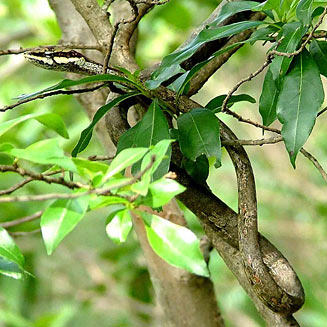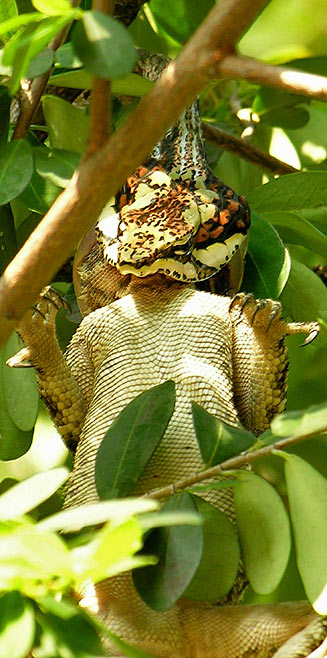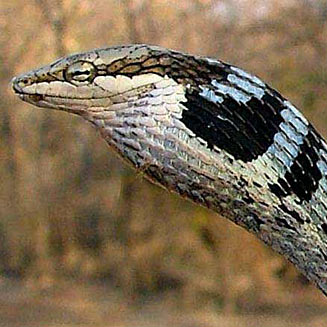|
Thelotornis capensis capensis (Southern vine snake, Twig snake,
Bird snake)
Savannevoelslang [Afrikaans]; Kotikoti [Ndebele]; Ukhokhothi
[Zulu]
Life >
Eukaryotes
>
Opisthokonta >
Metazoa
(animals) > Bilateria > Deuterostomia >
Chordata >
Craniata > Vertebrata (vertebrates) > Gnathostomata (jawed vertebrates) >
Teleostomi (teleost fish) > Osteichthyes (bony fish) > Class:
Sarcopterygii (lobe-finned fish) > Stegocephalia (terrestrial vertebrates) >
Tetrapoda
(four-legged vertebrates) > Reptiliomorpha > Amniota >
Reptilia (reptiles) >
Romeriida > Diapsida > Lepidosauromorpha > Lepidosauria >
Squamata > Serpentes
(snakes) > Family: Colubridae > Subfamily:
Colubrinae > Genus:
Thelotornis
 |
 |
 |
|
Top: Twig snake doing its best to look like a
twig. Photographed in Kwazulu-Natal, South Africa. [A. Kruger ©, from
SARCA Virtual Museum].
Bottom: Twig snake in threat posture with neck inflated. [G.
Tomsett ©, from
SARCA Virtual Museum] |
Twig snake in the process of swallowing what is
probably a tree agama (Acanthocercus), which it had captured.
Photographed in Mpumalanga, South Africa. [J. Hurter ©, from
SARCA Virtual Museum] |
Identification
Can be identified by a long pointed head, a distinctive
keyhole shaped pupil, a dull grey or grey brown colouration (often with dark
blotches), a green or green
blue head, a dark line running between the eye and mouth, and its red and black
tongue. It can also be recognized by the way its neck when threatened. This
snake reaches an average length of 1.2 meters but may also reach just under 1.5
meters.
Distribution and habitat
The Southern Vine snake is found in the following areas of
southern Africa:
Mpumalanga, Limpopo, North West province, Swaziland, southern Zimbabwe and
eastern Botswana. Its favoured habitat is lowland forest and moist savanna.
Food
Feeds on lizards (including chameleons),
frogs and
occasionally birds and other snakes.
Predators, parasites and disease
Fed on by
birds of prey (particularly
secretary birds and
snake eagles) and other snakes.
Reproduction
Oviparous (egg laying), laying between 4 and 18 eggs in
summer and is known to produce more than one clutch per season.
Longevity
Has an average lifespan of 10 years.
Medical importance
This Vine snake species has potentially lethal haemotoxic
venom, A bite from this snake constitutes a medical emergency especially since no
antivenom is available. Luckily it is seldom encountered and deaths
are exceptionally rare.
Links
References
-
Broadley, D.G. 1983. FitzSimons' Snakes of Southern
Africa. Delta Books, Johannesburg.
-
Marais, J. 2004. A Complete Guide to Snakes of Southern Africa.
Struik Publishing, Cape Town.
|
